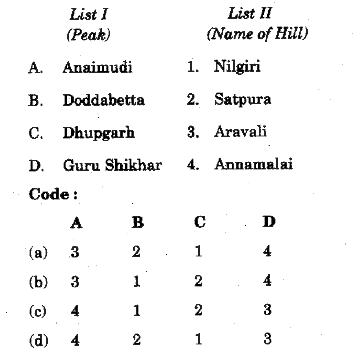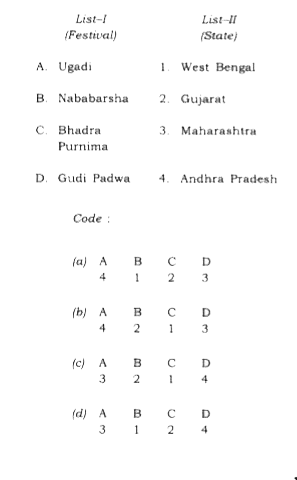Match List-I (complex ions) with List-II (number of unpaired electrons) and select the correct answers using the codes given below lists:
List−IList−II(Complexion)(NumberofUnpairedElectrons)A.[CrF6]4−1.OneB.[MnF6]4−2.TwoC.[Cr(CN)6]4−3.ThreeD.[Mn(CN)6]4−4.Four5.Five
(a) ABCD4125
(b) ABCD2531
(c) ABCD4521
(d) ABCD2135
The correct Answer is:C
To solve the problem, we need to determine the number of unpaired electrons in each of the given complex ions from List-I and match them with the corresponding values from List-II.
1. Identify the oxidation states and electron configurations:
- (A) (CrF₆)⁴⁻:
- Chromium (Cr) has an oxidation state of +2 (since F is -1 and there are 6 F atoms: -6 + x = -4, thus x = +2).
- The electron configuration of Cr is (Ar) 3d⁵ 4s¹. For Cr²⁺, it becomes (Ar) 3d⁴.
- (B) (MnF₆)⁴⁻:
- Manganese (Mn) has an oxidation state of +2 (similar reasoning as above).
- The electron configuration of Mn is (Ar) 3d⁵ 4s². For Mn²⁺, it becomes (Ar) 3d⁵.
- (C) (Cr(CN)₆)⁴⁻:
- Chromium (Cr) is again +2.
- The electron configuration remains (Ar) 3d⁴ for Cr²⁺.
- (D) (Mn(CN)₆)⁴⁻:
- Manganese (Mn) is +2.
- The electron configuration remains (Ar) 3d⁵ for Mn²⁺.
2. Determine the nature of the ligands:
- F⁻ is a weak field ligand, which does not cause pairing of electrons.
- CN⁻ is a strong field ligand, which causes pairing of electrons.
3. Count the unpaired electrons:
- (A) (CrF₆)⁴⁻:
- 3d⁴ with weak field ligand (F⁻): 4 unpaired electrons.
- (B) (MnF₆)⁴⁻:
- 3d⁵ with weak field ligand (F⁻): 5 unpaired electrons.
- (C) (Cr(CN)₆)⁴⁻:
- 3d⁴ with strong field ligand (CN⁻): 2 unpaired electrons (pairing occurs).
- (D) (Mn(CN)₆)⁴⁻:
- 3d⁵ with strong field ligand (CN⁻): 1 unpaired electron (pairing occurs).
4. Match the results with List-II:
- (A) (CrF₆)⁴⁻: 4 unpaired electrons → matches with 4.
- (B) (MnF₆)⁴⁻: 5 unpaired electrons → matches with 5.
- (C) (Cr(CN)₆)⁴⁻: 2 unpaired electrons → matches with 2.
- (D) (Mn(CN)₆)⁴⁻: 1 unpaired electron → matches with 1.
Final Matching:
- A → 4
- B → 5
- C → 2
- D → 1
Codes:
The correct matching codes would be:
- A - 4
- B - 5
- C - 2
- D - 1
- (A) (CrF₆)⁴⁻:
- Chromium (Cr) has an oxidation state of +2 (since F is -1 and there are 6 F atoms: -6 + x = -4, thus x = +2).
- The electron configuration of Cr is (Ar) 3d⁵ 4s¹. For Cr²⁺, it becomes (Ar) 3d⁴.
- (B) (MnF₆)⁴⁻:
- Manganese (Mn) has an oxidation state of +2 (similar reasoning as above).
- The electron configuration of Mn is (Ar) 3d⁵ 4s². For Mn²⁺, it becomes (Ar) 3d⁵.
- (C) (Cr(CN)₆)⁴⁻:
- Chromium (Cr) is again +2.
- The electron configuration remains (Ar) 3d⁴ for Cr²⁺.
- (D) (Mn(CN)₆)⁴⁻:
- Manganese (Mn) is +2.
- The electron configuration remains (Ar) 3d⁵ for Mn²⁺.
- F⁻ is a weak field ligand, which does not cause pairing of electrons.
- CN⁻ is a strong field ligand, which causes pairing of electrons.
- (A) (CrF₆)⁴⁻:
- 3d⁴ with weak field ligand (F⁻): 4 unpaired electrons.
- (B) (MnF₆)⁴⁻:
- 3d⁵ with weak field ligand (F⁻): 5 unpaired electrons.
- (C) (Cr(CN)₆)⁴⁻:
- 3d⁴ with strong field ligand (CN⁻): 2 unpaired electrons (pairing occurs).
- (D) (Mn(CN)₆)⁴⁻:
- 3d⁵ with strong field ligand (CN⁻): 1 unpaired electron (pairing occurs).
- (A) (CrF₆)⁴⁻: 4 unpaired electrons → matches with 4.
- (B) (MnF₆)⁴⁻: 5 unpaired electrons → matches with 5.
- (C) (Cr(CN)₆)⁴⁻: 2 unpaired electrons → matches with 2.
- (D) (Mn(CN)₆)⁴⁻: 1 unpaired electron → matches with 1.
- A → 4
- B → 5
- C → 2
- D → 1
The correct matching codes would be:
- A - 4
- B - 5
- C - 2
- D - 1
Topper's Solved these Questions
- BOOK - A2ZCHAPTER - COORDINATION COMPOUNDSEXERCISE - Crystal Field Theory (Cft)16videos
COORDINATION COMPOUNDS
- BOOK - A2ZCHAPTER - COORDINATION COMPOUNDSEXERCISE - Metal Carbonyls, Stability Of Complexes And Applications23videos
COORDINATION COMPOUNDS
- BOOK - A2ZCHAPTER - COORDINATION COMPOUNDSEXERCISE - Optical Isomerism22videos
COORDINATION COMPOUNDS
- BOOK - A2ZCHAPTER - CHEMICAL KINETICSEXERCISE - Section D - Chapter End Test30videos
CHEMICAL KINETICS
- BOOK - A2ZCHAPTER - ELECTROCHEMISTRYEXERCISE - Section D - Chapter End Test30videos
ELECTROCHEMISTRY
Similar Questions
Match List I with List II and select the correct answer using the code given below the lists:
 View Solution
View SolutionMatch List I with List II and select the correct answer using the code given below the lists:
 View Solution
View SolutionMatch List I with List II and select the correct answer using the code given below the lists:
 View Solution
View SolutionMatch List I with List II and select the correct answer using the code given below the Lists :
 View Solution
View SolutionMatch List-I with List-II and select the correct answer using the code given below the Lists :
 View Solution
View SolutionMatch List I with List II and select the correct answer using the code given below the Lists:
 View Solution
View SolutionMatch List-I with List-II and select the correct answer using the code given below the Lists :
 View Solution
View SolutionMatch List-I with List-II and select the correct answer using the code given below the Lists :
 View Solution
View SolutionMatch List-I with List-II and select the correct answer using the code given below the Lists :
 View Solution
View SolutionMatch List -I with List -II and select the correct answer using the code given below the lists:
 View Solution
View Solution

